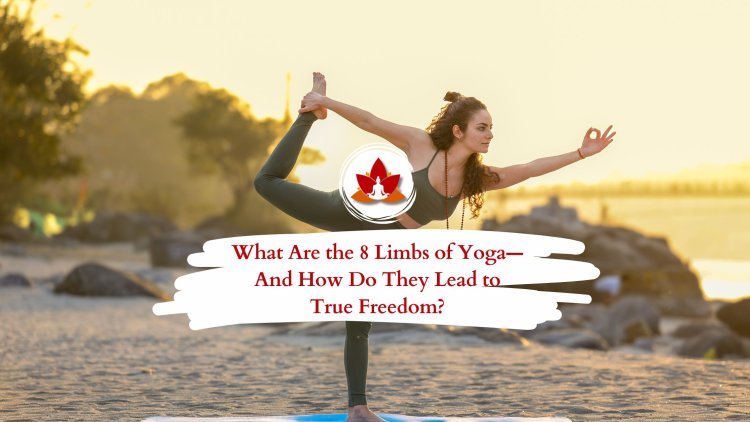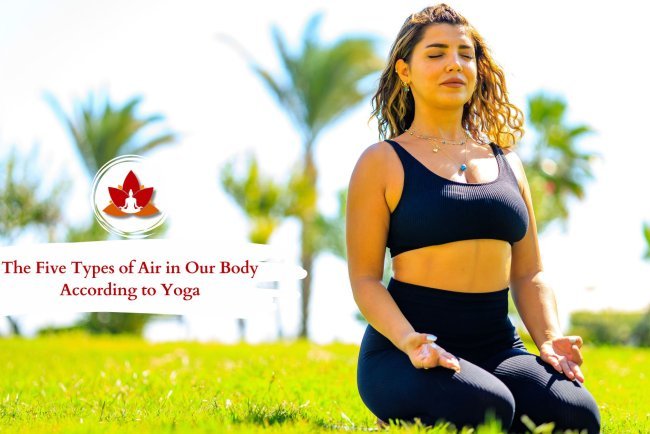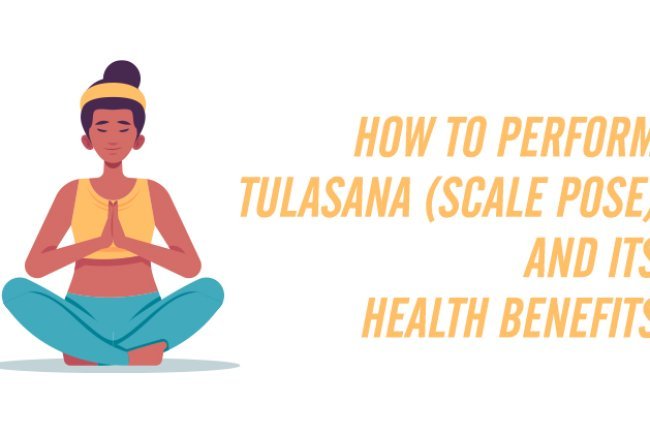What Are the 8 Limbs of Yoga—And How Do They Lead to True Freedom?

According to Patanjali’s Yoga Sutras, there is a clear path to liberation—an eight-fold system known as the Ashtanga Yoga System, or more commonly, the 8 limbs of yoga. (‘Ashta’ means eight, and ‘anga’ means limb in Sanskrit.) But how do we actually access this freedom through yoga? Is it through buying a ridiculously expensive pair of yoga pants?
Or by going on a trendy detox retreat? Or maybe just finally being able to touch your toes?
Probably not…
True freedom in yoga doesn’t come from external appearances—it comes from a deep, inner transformation. And that’s exactly what the 8 limbs of yoga are designed to facilitate.
In this post, we’ll dive into each of the 8 limbs of yoga, exploring their deeper meanings, their practical application in daily life, and how they serve as stepping stones toward spiritual balance and self-realization.
From ethical living (Yamas and Niyamas) to meditative absorption (Samadhi), this ancient path teaches us how to move beyond the physical and cultivate a life of inner clarity, peace, and purpose.
Through the study and practice of the 8 limbs of Ashtanga Yoga, practitioners can develop a grounded, intentional, and enlightened way of living—on and off the mat.
What is yoga?
The word ‘yoga’ comes from the Sanskrit root yuj, which means to join or unite. What we seek to unite in yoga is the true Self—also known as the atman, divine essence, or ultimate self. You might also think of it as connecting with the soul.
But yoga is not only about union. It also implies separation—specifically, the disentanglement from what hinders our freedom. In other words, yoga is the path of removing obstacles that block us from experiencing our truest nature.
The ultimate goal of all yoga practices—whether physical postures, breathwork, or meditation—is to reach moksha: a state of liberation, freedom, and inner peace.
What are the Eight limbs of yoga?
The term Ashtanga comes from Sanskrit: ashta meaning “eight” and anga meaning “limb.” It refers to the eightfold path outlined in Patanjali’s Yoga Sutras, commonly known as the eight limbs of yoga.
These eight steps serve as a comprehensive guide for living a meaningful and balanced life. They are designed to help us cultivate self-discipline, deepen our spiritual awareness, and ultimately experience liberation (moksha).
Far beyond physical postures, the eight limbs of yoga emphasize moral and ethical living, personal growth, inner focus, and meditative absorption. When practiced together, they promote not only well-being and self-control, but also a deeper realization of our true spiritual nature.
Understanding the 8 Limbs of Ashtanga Yoga:
The 8 limbs of Ashtanga Yoga, as outlined in Patanjali’s Yoga Sutras, offer a complete path for personal transformation and spiritual development. Each limb is a progressive step that leads toward a life of balance, clarity, and ultimately, liberation (moksha). Here's a closer look at the first two foundational limbs:
1. Yama – Moral Restraints and Ethical Principles
The first limb of the 8 limbs of yoga, Yama, addresses how we interact with the world around us. These are universal ethical guidelines that help us create harmony in our relationships and the environment. Yama reminds us that yoga extends far beyond the mat—it is a way of life.
The five Yamas are:
-
Ahimsa (Non-Violence): Practicing kindness and compassion toward all living beings—physically, mentally, and emotionally. Ahimsa helps cultivate peace within and around us.
-
Satya (Truthfulness): Aligning our words and actions with our inner truth, fostering trust and authenticity in all relationships.
-
Asteya (Non-Stealing): Respecting others’ time, space, and energy. This encourages contentment and gratitude for what we already have.
-
Brahmacharya (Moderation): Channeling desires with awareness. It promotes balanced energy and wise relationships, traditionally linked to celibacy but now interpreted as mindful moderation.
-
Aparigraha (Non-Possessiveness): Letting go of material attachment and cultivating simplicity. True joy, it teaches, comes from within—not from accumulation.
As B.K.S. Iyengar explained in Light on the Yoga Sutras, the Yamas are "unconditioned by time, class, and place," meaning anyone—regardless of their background—can strive to embody them.
2. Niyama – Personal Observances and Inner Discipline
The second limb, Niyama, refers to internal practices that guide us toward self-mastery and spiritual insight. If Yama teaches us how to treat others, Niyama teaches us how to treat ourselves.
The five Niyamas are:
-
Saucha (Cleanliness): Purity of body and mind. It encourages healthy habits, inner calm, and emotional clarity.
-
Santosha (Contentment): Finding satisfaction in the present moment. Santosha invites us to let go of comparison and embrace what is.
-
Tapas (Discipline): The inner fire of determination and willpower. Tapas helps us endure challenges and grow stronger through dedicated practice.
-
Svadhyaya (Self-Study): Reflection on the self and sacred texts. This leads to deeper awareness of our patterns and connection with the universe.
-
Ishvara Pranidhana (Surrender to the Divine): Letting go of ego and control. Trusting in a higher power or universal intelligence leads to humility and grace.
The Niyamas align beautifully with the Koshas (layers of being), guiding us from the outermost physical self to our innermost truth.
3. Asana – The Physical Postures
The third limb of the 8 limbs of yoga, Asana, is perhaps the most well-known in modern yoga—but often the most misunderstood.
While many associate asana with handstands, deep backbends, or visually impressive postures, the original intent was much simpler. In Patanjali's Yoga Sutras, asana means “seat”—specifically, the steady and comfortable seat taken for meditation. The only instruction Patanjali offers is:
“Sthira Sukham Asanam” – The posture should be steady and comfortable.
In ancient texts like the Hatha Yoga Pradipika, various seated meditation poses such as Padmasana (Lotus Pose) and Virasana (Hero Pose) are mentioned. However, the essence of asana is not the complexity of the posture, but its ability to foster stillness and ease—sthira (steadiness) and sukha (ease).
Purpose of Asana in the Path of Ashtanga Yoga
In the context of Ashtanga Yoga, asanas serve a specific purpose that goes far beyond aesthetics. They are tools for preparing the body and mind for deeper states of awareness and stillness.
1. Build Strength, Flexibility & Balance
Regular asana practice improves physical health, strengthens the muscles, enhances flexibility, and creates postural balance—all of which support a more sustainable and stable meditation practice.
2. Prepare the Body for Stillness
A core function of asana is to condition the body so that it can remain seated for extended periods without discomfort or distraction. When the body is no longer a source of restlessness, the mind can dive deeper into meditation.
3. Sharpen Mental Focus
Each asana becomes a meditation in motion. As we hold and breathe through postures, we learn to focus the mind, cultivating awareness, mindfulness, and inner steadiness.
A Reminder for Your Practice
The true asana practice asks us:
"In how many poses are we truly steady and at ease?"
So next time you’re in a yoga class, rather than automatically choosing the most advanced version of a posture, ask yourself:
“Can I be comfortable and present in this variation?”
That’s the heart of the third limb of the 8 limbs of yoga—a body that is both still and strong, serving as a stable foundation for spiritual growth.
4. Pranayama – Breath Control
Pranayama is the fourth limb of the 8 limbs of yoga, and it holds a transformative key to our inner evolution. The term itself can be broken down into two roots:
-
Prana – the vital life force or energy that animates us, often linked to the breath
-
Ayama – meaning extension, expansion, or control
Together, Pranayama can be translated in several ways:
-
Breath control
-
Breath restraint
-
Expansion of life force
-
Liberation through breath
This dual nature reflects the practice itself: while some techniques focus on discipline and control, others encourage flow, release, and energetic expansion. Both paths aim toward greater awareness and personal freedom—core intentions behind the Ashtanga Yoga system.
5. Pratyahara – Withdrawal of the Senses
As the fifth limb in the 8 limbs of yoga, Pratyahara marks a pivotal turning point—from external engagement to internal exploration.
The Sanskrit root “pratya” means to withdraw, draw in, or draw back, and “ahara” refers to that which we take in—our sensory experiences: sights, sounds, smells, tastes, and tactile sensations. Thus, pratyahara means the conscious withdrawal from the sensory overload that constantly occupies our minds.
What Is Sense Withdrawal Really About?
Contrary to popular belief, pratyahara does not mean turning off the senses like flipping a switch. We don’t stop seeing, hearing, or feeling. Instead, we train the mind to become so focused inward that external stimuli lose their grip on our attention.
This inward-turning is often the first step in meditation—drawing attention away from the outer world and guiding it inward, often through the breath, which links this limb closely with the previous one, pranayama.
How Pratyahara Supports Your Practice
1. Reduces External Distractions
By consciously withdrawing attention from sensory inputs, pratyahara creates space for inner stillness. It allows the practitioner to become less reactive and more present.
2. Prepares the Mind for Meditation
Pratyahara is the bridge between the outer-focused practices (like asana and pranayama) and the inner practices of meditation. By disengaging from the senses, the mind becomes quiet, concentrated, and ready for dharana (focused concentration), the next limb.
3. Cultivates Deep Self-Awareness
This practice invites introspection. It helps the practitioner observe their inner world—thoughts, emotions, and habits—without external interference, creating opportunities for growth and insight.
Living Pratyahara Off the Mat
Experienced yogis begin to embody pratyahara beyond the mat—staying deeply present even in noisy, busy environments. It’s not about escaping the world but about choosing where your attention lives.
In the broader path of the Ashtanga Yoga system, pratyahara is the gateway that leads us from outer discipline to inner freedom—an essential milestone on the spiritual journey.
6. Dharana – Concentration
Dharana, the sixth limb of the 8 limbs of yoga, refers to focused concentration. The Sanskrit root “dha” means to hold or maintain, and “ana” implies something else. Together, dharana is the act of holding the mind steady on a single object of focus.
Closely connected with pratyahara (sense withdrawal), dharana marks the first of the three inner limbs (antaranga) that lead deeper into the meditative and spiritual dimensions of yoga. While pratyahara draws the senses inward, dharana trains the mind to stay there.
Why Dharana Matters in Your Practice
1. Builds Mental Discipline
By repeatedly bringing the wandering mind back to one point of focus—be it the breath, a mantra, or a visual image—dharana strengthens concentration and sharpens clarity. It's the essential mental training for stability and inner resilience.
2. Prepares the Ground for Meditation (Dhyana)
Dharana is not yet meditation, but it's the doorway. It’s through cultivating concentration that we access deeper meditative states. Without focus, the mind drifts; with dharana, it becomes anchored.
3. Deepens Self-Awareness
Focusing attention on a specific object, thought, or spiritual ideal brings heightened inner awareness. Whether visualizing a deity, repeating a mantra, or watching the breath, dharana allows the practitioner to turn inward with intention and purpose.
Techniques of Dharana
-
Trataka – Gazing at a candle flame without blinking
-
Visualization – Focusing on a specific image or spiritual symbol
-
Breath awareness – Following the inhalation and exhalation
-
Mantra japa – Repetition of a sacred sound or word
These are not just tools for meditation, but core dharana techniques that still the mind and refine awareness.
The Truth About Dharana
Many practitioners believe they're meditating when in fact, they’re in dharana. True meditation (dhyana) begins when focus becomes effortless and uninterrupted. But dharana is where it starts—the vital step where discipline turns into depth.
As a part of the Ashtanga Yoga system, dharana is the practice of learning to focus—because only when the mind is focused can it truly be free.
7. Dhyana – Meditation
Dhyana, the seventh limb of the 8 limbs of yoga, refers to meditative absorption—a state where awareness is steady, uninterrupted, and deeply internalized. This is the true experience of meditation, where you become one with the object of your focus.
Many techniques taught in yoga classes—such as mantra repetition, breath awareness, or visualization—are preparatory practices. They help calm the nervous system and train the mind for this deeper state of stillness. But dhyana itself arises naturally when concentration (dharana) becomes effortless and continuous.
Why Dhyana Matters
1. Creates Inner Tranquility
Regular meditation cultivates a profound sense of peace and stillness within. Dhyana allows the mind to quieten so completely that the practitioner experiences calm beyond thought or emotion.
2. Develops Self-Realization
Through deep meditation, practitioners gain insight into their true nature—the Self (Atman). This self-inquiry leads to spiritual awakening and a clearer sense of one's place in the universe.
3. Elevates Consciousness
As dhyana deepens, it opens the gateway to expanded states of awareness. One may experience connection with the divine, universal energy, or a blissful silence that transcends ordinary thinking.
The Subtle Nature of Meditation
Unlike asana or pranayama, dhyana cannot be "done" in a mechanical sense. It's not a technique but a state of being. Ironically, when you're truly meditating, you won’t even have the thought “I’m meditating.” You simply are. The sense of self fades into the act of presence.
In the Journey of the 8 Limbs of Yoga…
Dhyana is the result of practicing the earlier limbs—ethical grounding (yama, niyama), physical discipline (asana), breath mastery (pranayama), and inner focus (pratyahara, dharana). It's the culmination of steady effort and a clear, inward gaze.
From here, the final limb—Samadhi—is just a breath away.
8. Samadhi – Enlightenment or Bliss
Samadhi, the eighth and final limb of the 8 limbs of yoga, represents the ultimate goal of the yogic path: a state of complete absorption, inner peace, and spiritual realization. While many interpret it as enlightenment or bliss, Samadhi is more about profound clarity and unity than mere emotional euphoria.
Breaking down the word:
-
Sama means “equal” or “same”
-
Dhi means “to see” or “to perceive”
Together, Samadhi refers to seeing things as they truly are—without distortion, preference, or attachment. It's a state of pure awareness in which the mind is no longer clouded by ego, distraction, or judgment.
What Happens in Samadhi?
1. Transcendence of the Ego
In Samadhi, the sense of a separate self dissolves. The practitioner experiences a deep connection with all of existence, realizing their true nature is not separate from the universe—but one with it.
2. Inner Bliss and Spiritual Joy
This is not fleeting happiness, but a serene, lasting joy rooted in spiritual awareness. It’s a state of being that goes beyond pleasure and pain—a peaceful bliss that arises from unity with the Self.
3. Unity with All That Is
The boundaries between self and other, body and spirit, past and future—all dissolve. In Samadhi, the practitioner perceives the interconnectedness of all life. This realization brings freedom, known in Sanskrit as moksha or liberation.
Samadhi and the 8 Limbs of Yoga
Samadhi is the natural culmination of a steady, sincere journey through the 8 limbs of yoga. Each step—from ethical living (yama and niyama), to physical discipline (asana), breath mastery (pranayama), inward focus (pratyahara), and deep concentration (dharana and dhyana)—prepares the mind for this final transformation.
It’s not about escaping reality or chasing blissful highs. Samadhi is about waking up—seeing reality clearly, and living in harmony with truth.
Applying the Eightfold Path to the Modern World
The 8 Limbs of Yoga, as outlined in Patanjali’s Yoga Sutras, are timeless teachings that offer profound insight for living a meaningful, balanced, and spiritually aligned life—even in our fast-paced modern world. Here's how these ancient principles can be applied practically today:
Live by the Yamas and Niyamas
Start by embracing right living (Yama) and personal discipline (Niyama). Practice honesty, non-violence, contentment, moderation, and self-study. These ethical and personal codes act as your internal compass, guiding everyday decisions with awareness and integrity.
Maintain a Consistent Yoga and Pranayama Practice
Incorporate regular Ashtanga Yoga postures (Asana) and controlled breathing techniques (Pranayama) to strengthen your body and steady your mind. Just a few minutes of daily mindful movement and breathwork can foster physical vitality and emotional balance.
Cultivate Inner Awareness and Focus
Withdraw from the noise of the outside world through Pratyahara (sense withdrawal), and sharpen your concentration with Dharana (focused attention). Even five minutes of intentional stillness or breath awareness can bring clarity amidst chaos.
Embrace Meditation and Seek Spiritual Connection
Dedicate time for Dhyana (meditation) to foster inner peace, and gradually move toward Samadhi—a state of pure awareness and unity. Meditation doesn’t have to be perfect; the key is consistency and openness.
Perceiving Life As It Truly Is
The philosopher Meister Eckhart once described this state as “Istigkeit”, or “is-ness”—the ability to see life exactly as it is, unfiltered by personal bias, attachments, or ego. This clarity is not about bliss or escape but about unwavering presence and pure perception.
However, Samadhi—the final stage of the 8 limbs of yoga—is not easily permanent. Patanjali reminds us that unless our mind is truly purified, free from attachments, aversions, and deep-rooted habits (samskaras), the state of Samadhi will be fleeting. Only when the mind is fully still and transparent can we access moksha, or liberation.
Final Words: Integrating the 8 Limbs of Yoga
The Eight Limbs of Ashtanga Yoga provide a profound blueprint for personal and spiritual growth. Far beyond physical flexibility, this system nurtures clarity, purpose, and inner freedom.
Whether you're a seasoned yogi or just beginning your journey, the integration of these limbs—ethics, discipline, physical practice, breath, withdrawal, focus, meditation, and transcendence—can transform your life from the inside out.
Start where you are. Walk the path steadily. The 8 limbs are not just steps but companions on a lifelong journey toward balance, awakening, and true peace.
What's Your Reaction?


























